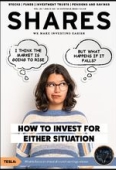Archived article
Please note that tax, investment, pension and ISA rules can change and the information and any views contained in this article may now be inaccurate.
Top performing US growth fund is ready to fight back after market sell-off

Having launched in April 2017, Brown Advisory US Mid Cap Growth Fund (BYW8R75) was in the top 25% performers in the Investment Association North American sector for the first three years of its existence. Then came a big shift in the market and it tumbled along with most other growth funds.
Despite having the wind knocked out of the fund’s sails, portfolio manager George Sakellaris remains remarkably upbeat about its prospects, albeit acknowledging that we’re still in a difficult environment.
The fund invests in US-listed stocks worth between $2 billion and $50 billion. While UK investors may only be familiar with a few of its holdings such as Chipotle Mexican Grill (CMG:NYSE), most of them are characterised as high-quality businesses.
In dollar terms, Brown Advisory US Mid Cap Growth generated a 134% total return between launch and 1 November 2021. That’s a remarkable return for investors over four and a half years and shows you what’s capable from investing in medium-sized companies. In contrast, the S&P 500 index of large cap companies returned quite a bit less at 107% over the same period.
In November 2021 a surge in interest rate expectations caused the market to rotate away from growth stocks to value ones. Funds like the one from Brown Advisory saw a big sell-off as investors were no longer prepared to pay high earnings multiples to access companies with higher than average growth prospects. They would rather pay a low multiple to invest in companies already making good money now, even though their earnings growth prospects were slimmer.
Brown Advisory US Mid Cap Growth fell 32% in dollar total return terms between 1 November 2021 and 6 October 2022, nearly twice as bad as the S&P 500’s 18% decline.
‘It’s been quite an extraordinary period,’ says Sakellaris. ‘I started my career at the height of the dotcom bubble and then my earliest years were in the bust of that. I never felt I would see something similar again, yet parts of 2020 and 2021 were a small echo of that.’
What’s the appeal of mid-cap stocks?
They often have a better opportunity to grow and take market share than large companies
They have an advantage over small companies because they’ve had time to mature and scale up, so they are usually more profitable
They often have professional management teams and better board structures than smaller companies
FINDING OPPORTUNITIES IN THE WRECKAGE
Before November 2021’s market rotation, the valuation of many growth stocks became excessive. Sakellaris says the Russell Mid Cap Growth index hit 41 times earnings in 2021. The only time in its entire history that it traded even higher was March 2000 at 55 times earnings, he adds.
Undeterred by the portfolio performance going into reverse, the Brown Advisory team sought to scour the market wreckage for opportunities. Quite a few high-quality businesses were suddenly available on much more reasonable valuations, so the team started buying.
One stock they seized upon was payroll software group Paycom (PAYC:NYSE) after its share price nearly halved in less than a year. It is taking market share from leaders Automatic Data Processing (ADP:NASDAQ) and Paychex (PAYX:NASDAQ), enjoying a 26% annual compound growth rate in sales and 23% in net profit, according to Stockopedia data.
It is also a beneficiary of rising interest rates because of the float (made up of client payroll funds) which is typically held for a period after receiving the cash from clients and before salaries are paid.
REALIGNING CONSUMER EXPOSURE
The fund has reduced its exposure to consumer-facing companies quite a bit since 2021 after seeing cracks appearing. Some holdings have been sold, while a few new positions have been taken.
‘About a year ago we started to have conversations that worried us about the low to middle income consumer in the US. We were lapping a lot of stimulus payments, child tax credits and other things that helped the consumer during the Covid bubble and which distorted demand.
‘We started to see the other side of that, such as a build-up in inventory and cracks in the credit quality of sub-prime consumers. When we see things like that, our one, two and three-year projections for companies change.’
It sold a stake in craft products website Etsy (ETSY:NASDAQ) while the share price was high, and it also exited a position in SiteOne (SITE:NYSE). This was a classic Covid beneficiary, supplying landscape products and seeing demand soar as people stuck at home sought to spruce up their indoor and outdoor living space.
Home improvements are now going into reverse as households cut back on their spending – after all, a new driveway or a pool is an easy decision to kick down the road. Nice to have, but not essential in darker times like now.
‘SiteOne had price and volume growth and the shares traded well above 20 times earnings before interest, tax, depreciation and amortisation. We then started to exit, and I think you’ll now see its product price and volumes go negative.’
BACKING SOMETHING DIFFERENT
The shift in consumer spending behaviour that we’re now seeing has prompted the Brown Advisory fund to take two new positions in what Sakellaris calls ‘counter-cyclical’ companies.
First is Dollar General (DG:NYSE) which at $54 billion is on the larger side of what you would typically find in the fund. It sells consumer staples to people on mid-to-low incomes. ‘When budgets come under pressure, this group of people trade down and seek out smaller basket and product sizes – that’s what Dollar General specialises in.’
It seems an obvious stock to own in the current environment, yet Sakellaris says this hasn’t seen investors bid up the valuation to excessive levels. ‘The valuation is fair. We think things will accelerate within the business.’
One stock that was certainly going cheap when the fund took a position this year was Five Below (FIVE:NASDAQ), a US business with a lot of similarities to UK retailer The Works (WRKS). Both sell cheap items including the latest playground craze such as fidget spinners or Squishmallows. Sakellaris says going into its stores is like a treasure hunt for teens and tweens, where $5 or $10 goes a long way.
‘Five Below has company-specific initiatives that could get same store sales growing again after a period of being up and down. It still has the opportunity to triple stores in the US.’
Many investors associate growth funds with taking higher risks, yet Brown Advisory US Mid Cap Growth has a more conservative approach, insists Sakellaris. It isn’t chasing ‘story stocks’ where there is a good narrative about what a company does and typically no sign of profits for many years ahead. Instead, it prefers to invest in high-quality businesses with good management teams and where growth durability is more important than the actual rate of growth. ‘We want growth to stay stronger for longer.’
A stock that ticks all these boxes is Waste Connections (WCN:NYSE), the biggest position in the fund. ‘The people operating the company have a stellar 20-year history of capital allocation. They’ve rolled up a fragmented industry in waste collection over many years. They’ve done it in a very profitable way with better return on capital and margins than peers.’
In October 2002, Waste Connections’ shares traded at $6.63, according to Google Finance. Today they’re at $131.99 which equates to a 1,890% return over 20 years.
WHAT MIGHT HAPPEN NEXT
Earnings are a key driver for share prices and there is a feeling that earnings estimates are still too high among US stocks. This raises the risk that share prices could fall even more than what we’ve seen so far this year.
Sakellaris agrees we could see further degradation in earnings estimates, saying things have slowed for many companies based on conversations his team have had with businesses. ‘People still expect 10% to 20% growth next year in the mid cap space. Anything is possibly, but it seems less and less likely.’
The portfolio manager says he doesn’t have a view of when the market will bottom out, but he does believe now is the first time in three to four years that it’s been possible to find quality growth companies at more reasonable prices.
He’s effectively bolstering his portfolio with more great businesses at much more attractive valuations and that should yield rewards in time. Investors simply need to be patient.
‘When there is a growth-led market drawdown, such as we saw with the dotcom bubble bursting, you would usually think that cyclical stocks lead the recovery. But you’ll find it is actually small and mid-cap growth stocks that are the best place to be when it happens.’
Important information:
These articles are provided by Shares magazine which is published by AJ Bell Media, a part of AJ Bell. Shares is not written by AJ Bell.
Shares is provided for your general information and use and is not a personal recommendation to invest. It is not intended to be relied upon by you in making or not making any investment decisions. The investments referred to in these articles will not be suitable for all investors. If in doubt please seek appropriate independent financial advice.
Investors acting on the information in these articles do so at their own risk and AJ Bell Media and its staff do not accept liability for losses suffered by investors as a result of their investment decisions.

 magazine
magazine








